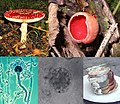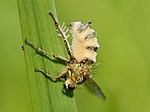Conidium (redirect from Conidiophore)
which are borne on specialized stalks called conidiophores. The morphology of these specialized conidiophores is often distinctive between species and, before...
15 KB (1,777 words) - 23:53, 11 May 2024
Botrytis (fungus) (section Conidiophore)
both agricultural and forest trees. It produces stout, dark, branching conidiophores that bear clusters of paler conidia (grey in mass) on denticles from...
7 KB (590 words) - 16:19, 15 October 2023
Alternaria alternata (section Conidiophore)
Individual conidiophores arise directly from substrate forming bushy heads consisting of 4–8 large catenate conidia chains Secondary conidiophores are generally...
15 KB (1,673 words) - 08:24, 1 February 2024
conidiospores are asexual spores produced by A. flavus during reproduction. The conidiophores of A. flavus are rough and colorless. Phialides are both uniseriate...
24 KB (2,829 words) - 15:22, 22 July 2024
from top left: Amanita muscaria, a basidiomycete; Sarcoscypha coccinea, an ascomycete; bread covered in mold; a chytrid; an Aspergillus conidiophore....
27 KB (2,962 words) - 18:44, 3 December 2023
the "grapes" refers to the bunching of the fungal spores on their conidiophores, and "ashes" just refers to the greyish colour of the spores en masse...
25 KB (2,832 words) - 18:56, 7 July 2024
An environmental isolate of Penicillium Hypha Conidiophore Phialide Conidia Septa...
200 KB (19,177 words) - 18:10, 27 August 2024
Aspergillus niger Photomicrograph showing the conidial head (conidiophore) of Aspergillus niger Details of the head by scanning electron microscopy Scientific...
34 KB (3,551 words) - 10:03, 12 July 2024
pathogenic fungus, large primary conidia are produced at the apex of a conidiophore which emerge from the intersegmental membranes. When the spores are mature...
6 KB (656 words) - 17:31, 23 May 2024
axis. The typical Trichoderma conidiophore with paired branches assumes a pyramidal aspect. Typically the conidiophore terminates in one or a few phialides...
18 KB (2,058 words) - 07:48, 19 May 2024
specialized hyphae, the conidiophores. Depending on the species they may be dispersed by wind or water, or by animals. Conidiophores may simply branch off...
54 KB (6,636 words) - 08:16, 26 August 2024
flask-shaped projection from the vesicle (dilated part of the top of conidiophore) of certain fungi. It projects from the mycelium without increasing in...
1 KB (78 words) - 17:14, 12 October 2023
candidum, P. expansum, and P. glaucum—all of which produced a brush-like conidiophore (asexual spore-producing structure). The common apple rot fungus P. expansum...
23 KB (2,374 words) - 20:15, 13 August 2024
has the form of a small cushion at the bottom of which short crowded conidiophores are formed. The spores escape through an opening at the top. Trigiano...
969 bytes (79 words) - 00:54, 20 August 2023
conidiophores are formed in the mass of fungal tissue called the stroma. Stroma is located in the black lesions of the infected leaves. Conidiophores...
10 KB (1,179 words) - 06:15, 8 August 2024
called 'dematiaceous'. The hyphae produce brown spore bearing organs, 'conidiophores', which are distinguished by their 'geniculate' [1] shape, meaning they...
5 KB (492 words) - 12:29, 11 August 2024
lacking fruiting bodies Order Moniliales (producing spores on simple conidiophores) Order Stilbellales (producing spores on synnemata) Order Tuberculariales...
11 KB (1,054 words) - 06:37, 9 August 2024
grows in filaments and reproduces asexually through the production of conidiophores and conidia. However, P. digitatum can also be cultivated in the laboratory...
31 KB (3,387 words) - 07:42, 22 June 2024
sphaerospermum conidiophores are branched, septate, and dark, up to 150–300 μm long and 3.5–4.0 μm wide. The structure of the conidiophores are tree-like...
16 KB (1,772 words) - 00:24, 19 April 2024
Fusarium oxysporum conidiophores stained by lactophenol cotton blue...
1 KB (83 words) - 02:56, 26 June 2023
Microscopy showing an Aspergillus fumigatus conidiophore. A. fumigatus is the most common cause of chronic pulmonary aspergillosis....
29 KB (2,907 words) - 09:58, 15 January 2024
fagacearum Spores produced by the oak wilt fungus (a) Endoconidia (b) Conidiophore Scientific classification Domain: Eukaryota Kingdom: Fungi Division:...
44 KB (4,323 words) - 01:39, 2 June 2024
rod-shaped structure collectively known as the conidiophore that in turn, extends from the hyphal tip. The conidiophore can grow anywhere between 3–5 millimeters...
30 KB (3,182 words) - 12:16, 13 July 2024
macronematous Having a morphologically different conidiophore from the vegetative hyphae; a specialized conidiophore. maculate Spotted; blotched. mantle A layer...
151 KB (13,044 words) - 14:10, 26 August 2024
included in a new genus created for species with verticillately branched conidiophores similar to those of Verticillium but differing in their final zigzag...
6 KB (540 words) - 19:54, 29 July 2024
and microconidia (smaller asexual reproductive structures) on short conidiophores. Macroconidia are hyaline, multiseptate, variable in form, fusiform...
4 KB (292 words) - 17:31, 26 October 2023
maturity, smooth, 12–14 × 5–7 mm, in clusters of 5 to 9 phialides. Conidiophores are simple, erect, smooth to rough, colorless to olivaceous, slightly...
21 KB (2,104 words) - 23:01, 18 March 2024
giganteus produces two types of conidiophores that have distinct stipes and vesicles. The first of these conidiophores are typically 2-3 mm tall, including...
18 KB (2,139 words) - 20:14, 10 January 2024
representative of Zygosporium Mont. with stacked chained vesicular conidiophores from India". Fungal Biology. 128 (3): 1735–1741. Bibcode:2024FunB..128...
242 KB (21,902 words) - 07:34, 27 August 2024
























